
| Home | Latest News | Active Sales | Active Auction | Past Auctions | Other Stuff | Contact Sheridan |
| Lot # | Date | Variety | Rarity | Grade | Description | # of Bids * | Hammer Price | Maximum Bid | Total Price | Photos |
|---|---|---|---|---|---|---|---|---|---|---|
| 1 | 1806 Pt. 6, Lg. Stars | O.110 Prime | R.7 | PCGS VG 8 | Making its inaugural auction appearance, this is a remarkable coin to open a remarkable sale. The O.110 die pair is an established rarity. In the mid-1960’s Paul Munson, BHNC member #2, discovered the variety, spotting it in the inventory of A & A Coins of Iowa City, Iowa. Munson specialized in the Heraldic Eagle series, 1801-1807. His collection included the charismatic 1806 Knob 6, No Stem O.108. Superior Galleries sold Munson’s coins in Oct. 1989, a featured part of the Jascha Heifetz Collection Sale. At the time, there were but 10 known examples of the O.110. (Are there even 20 today?) Munson’s was an XF-AU example, but cleaned. Each example then known displayed a prominent obverse die break from the rim between stars 10-11 to Ms. Liberty’s mouth. Munson’s friend and contemporary, Richard Pugh, coined the term Elephant Trunk to reference the variety. It was not until the 1990’s that an example without an Elephant Trunk appeared. The current offering, a new discovery, is the 4th known example of the prime die state. I find no record of a prior auction appearance. The rarity of the O.110 confirms an early fracture and resulting failure of the obverse die. The coin is well circulated with natural grey toning, lighter on the devices. There are disturbances under the left side of the date and inside stars 2 and 3, nothing inconsistent with the modest VG grade. Expect stern competition for this exceedingly rare “prime” example of the O.110. The O.110 features a large-star punch, the only pointed 6 variety to do so. The stars appear larger than on any other die of the year. It remains a strong candidate for inclusion in a forthcoming edition of the Red Book. Est. $7,500 and up. | 0 | $0 | $0 | Not Sold |
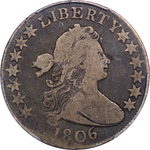
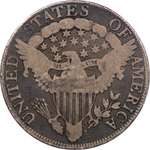
|
| 2 | 1806 Pt. 6 with stem | O.116 | R.3 | PCGS AU 58 | An especially pretty example of the type. Intense, iridescent rainbow colors envelop stars 1-8, the adjoining fields and Liberty’s curls. The lustrous reverse is largely untoned. Obverse and reverse die breaks are well advanced, adding character to this beguiling remnant of the early Mint. The lower left wing is soft, indicative of the late die state, while the upper wing feathers, Liberty’s lower curls and drapery lines are razor sharp. Est. $7,500 to $8,000. | 0 | $0 | $0 | Not Sold |
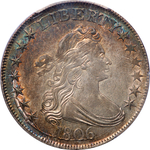
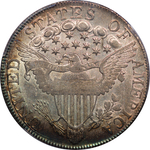
|
| 3 | 1807 Draped Bust | O.103 | R.3 | PCGS VF 20 CAC | The surfaces are exceptionally smooth for the grade. The central devices are a bit soft, as struck. Natural toning throughout. A handsome coin, acquired by a BHNC member from your cataloguer during the 2014 ANA Convention. Earlier in the collection of James Ross. Est. $750 to $950. | 1 | $650 | $675 | $715 |
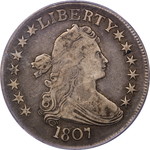
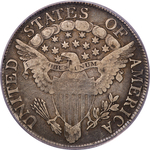
|
| 4 | 1807 Cap Bust | O.111 Prime | R.7 | PCGS F.12 | I’ve not before encountered a true prime of the O.111. The die marriage, of course, is best known for its late state: the bearded goddess, O.111b. The familiar die break that joins Liberty’s chest and chin is invariably accompanied by a 2nd, less remarkable, die break joining stars 1-6. The peripheral die break is also seen on the intermediate state, O.111a, where Liberty’s “beard” is thin, incomplete, or just a nub on her chest. The early die state, O.111, with no sign of an interior die break, is given an R.6 rarity rating in Overton/Parsley’s 5th edition. The few examples I’ve seen display some portion of the peripheral break through the left-hand stars. Not here! Under high magnification I see no evidence of a break between any stars. To my knowledge, this piece is the earliest known die state of the O.111 die pair. The coin was spotted and acquired by the consignor in a PCGS 1807 Small Stars holder! PCGS has corrected its error. The label now includes the proper O.111 attribution. The coin is without defects. The obverse sports natural grey toning with a thin ring of album toning; the reverse toning is more colorful, though somewhat uneven. This may be a once-in-a-lifetime opportunity. Est. $5,000 and up | 5 | $3,610 | $9,191 | $3,971 |
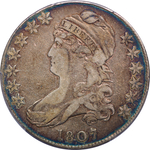
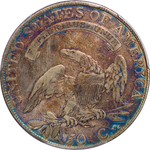
|
| 5 | 1807 50/20 | O.112 | R.1 | PCGS AU 53 | A sparkling example of the most common 1807. Album toning enhances the cartwheel luster. The reverse toning is confined to the legend, showcasing the eagle. The surfaces are lightly clashed but otherwise smooth. This is a high-end “AU 53.” From the collection of Dr. Charles Link. Est. $2,250-$2,500. | 1 | $2,250 | $4,500 | $2,475 |
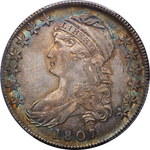
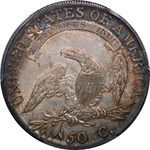
|
| 6 | 1807 Sm. Stars | O.113a | R.2 | PCGS AU 55 | Keith Davignon’s set piece since he acquired it in June 1994 (via your cataloguer) from my great friend, Dr. Gerald “Jerry” Schertz. This is a lovely coin, sparkling with even, pastel gold toning and soft luster. The strike is distinctly better than most from this coveted die pair. Note, especially, the high rims and well-defined dentils. A short scrape, right of the date, under the lowest curls will earmark the coin for generations to come. It has no other consequence. Recent auction records for the Small Stars variety in nice AU are scanty and scary! This is a trophy coin. Bid accordingly. Est. $5,000 to $10,000. | 7 | $9,650 | $13,200 | $10,615 |
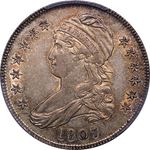
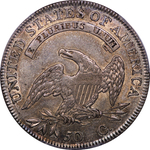
|
| 7 | 1808/7 | O.101 | R.1 | PCGS AU 53 CAC | A colorful piece, featuring shades of rust and gold interspersed with pale to deep turquoise. Some striking weakness in the centers. Nice luster and no marks of consequence. From the collection of Dr. Charles Link. Est. $2,400 to $3,000. | 0 | $0 | $0 | Not Sold |
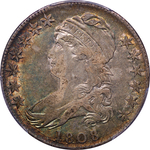
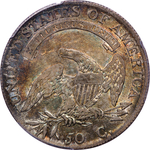
|
| 8 | 1808/7 | O.101 | R.1 | PCGS XF 45CAC | Soft luster throughout. Halos of iridescent gold run through the stars and legend. A high end XF with top flight eye appeal. From the collection of Dick Graham, author of the seminal work on reeded edge bust half-dollars. Est. $800 to $1,200. | 8 | $905 | $927 | $996 |
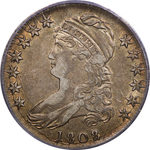
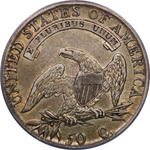
|
| 9 | 1808 | O.107a | R.2 | PCGS AU 58 | A blast of unabashed luster greets the beholder. This well struck, untoned jewel never entered circulation. Miniscule signs of handling keep it from a mint state designation. Here is an 1808 bust half that carries the “wham” we expect from our AU 58 bust halves. From the Davignon Collection. Acquired privately from your cataloguer in April 1999; at that time housed in an NGC MS 61 holder. Est. $2750 to $3,500. | 4 | $4,521 | $4,650 | $4,973 |
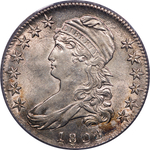
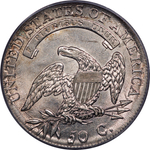
|
| 10 | 1809 Dbl. Edge Lets. | O.111 | R.2 | PCGS AU Details, cln'd | An AU coin with attractive pewter grey toning that obscures hairlines from an old cleaning. Ex Don Frederick. Lot 2903 in Heritage’s April 2010 sale of his collection. Frederick was BHNC #11. His personal notes mention the double lettering as well as the remarkably early die state. This die pair rarely comes with high rims and sharp dentils. From the Dr. Charles Link collection. Est. $300 to $500. | 8 | $555 | $555 | $610 |
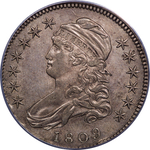
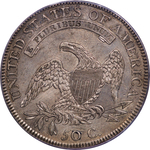
|
| 11 | 1809 | O.112 | R.5- | PCGS XF 45 CAC | Light grey toning. Good luster through the stars and legend, softer in the moderately hairlined fields. Ex Charlton E. Meyer, Jr. and so noted on the PCGS label. This coin is plated in the 3rd, 4th and 5th editions of Overton’s standard reference. It stands today as #5 in the Condition Censes. Meyer purchased it in August 1974 from Gary Lonnon, an early BHNC member, paying the grandiose sum of $240! The coin last appeared in Stack’s January 2009 Americana-Philadelphia Sale, lot 5159 where it brought $1,725. Overton Plate coins rarely appear on the market. Most remain with the Overton Collection, held by a private collector since July 1993 when your cataloguer negotiated a private sale of the collection on behalf of Overton’s daughter and son-in-law, Bonnie and Donald Parsley. The consignor’s notes indicate that Harry Laibstain purchased this coin at the Jan. 2009 Stack’s sale. Laibstain sold it privately to Dr. Charles Link. In May 2010 Dr. Link located a better coin and sold this one to the consignor. Est. $2,000 to $3,000. | 1 | $1,500 | $1,500 | $1,650 |
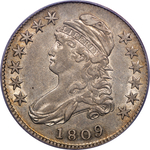
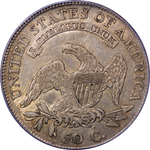
|
| 12 | 1810 | O.101a | R.1 | PCGS AU 55 CAC | Light to medium grey with pale gold highlights in and around the devices, esp. on the reverse. Well struck for this die pair, with high rims, sharp dentils and but a hint of weakness in the left wing. From the Davignon Collection. Est. $1,800 to $2,500. | 3 | $1,675 | $1,675 | $1,843 |
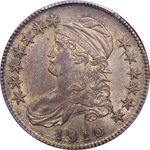
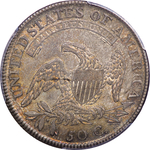
|
| 13 | 1810 | O.102 | R.1 | PCGS AU 58 CAC | This stunning coin is unlike any other O.102 I’ve seen. Allow me to quote its owner, Keith Davignon, a man not prone to hyperbole: “The holy grail” of strikes! Nearly complete left wing on a 102!! I searched over 20 years to find a 102 with decent feather detail on left wing. This coin has [semi] proof-like, razor sharp obverse detail. [The] scroll on reverse has texture like tree bark. Keith omits mention of unbroken, blinding luster. A whisper of friction on the cheek requires direct light and a dose of imagination to detect. Purchased from Acropolis Coins in an NGC MS 61 holder at the 2008 Baltimore ANA Convention. [NGC label accompanies.] Est. $4,000 and up. | 1 | $3,500 | $3,500 | $3,850 |


|
| 14 | 1811/10 | O.101 | R.1 | PCGS AU 55 CAC | A magnificent specimen! Cakey luster lies beneath the regal grey patina. Stars 8-13 are infused with iridescent flavors of gold and turquoise. Originality is a watchword for this offering. The reasonably early die state allows us to see remnants of the 0, top-right of the second 1. Est. $4,000 to $4,500. | 1 | $4,000 | $5,500 | $4,400 |
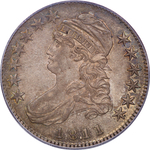
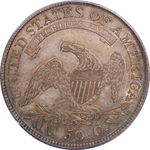
|
| 15 | 1811 Lg. 8 | O.104a | R.1 | PCGS AU 55 | Another handsome early date. Keith Davignon purchased the coin from Brian Greer in December 1997. It came to the current consignor via Mail Bid Sale 39, lot 9 (@ $2,239) where I described it as follows: Gold and turquoise dominate the obverse. The reverse is very lightly toned. Swirling obverse die breaks hallmark this die pair. The luster is just what we expect from the assigned grade. Est. $1,900 to $2,400. | 1 | $1,900 | $3,500 | $2,090 |
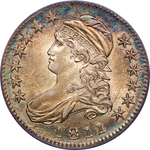
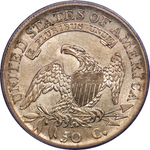
|
| 16 | 1811 Sm.8 | O.107 | R.4 | PCGS AU 58 CAC | A superb example of the coveted early die state. Iridescent album toning graces the obverse periphery. Striking weakness is limited to the left wing and claws below. Boisterous luster throughout. From the Davignon Collection. Keith acquired the coin from Dr. Link by private treaty in March 2015. The PCGS label notes the Link provenance. Est. $3,000 to $3,750 | 9 | $5,175 | $5,175 | $5,693 |
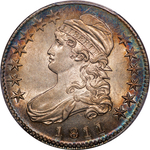
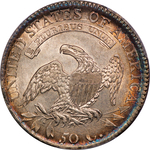
|
| 17 | 1811 Sm.8 | O.110a | R.1 | PCGS MS 61 OGH | The luster is as bold and fresh as the day it dropped from the press, 205 years ago. The evenly struck devices are beautifully impressed. Not a hint of friction on the high points. An “upgrade” candidate, as are many still housed in PCGS “Old Green Label Holders.” From the Davignon Collection, acquired privately in February 2002. Est. $3,000 to $3,500. | 1 | $2,900 | $3,300 | $3,190 |
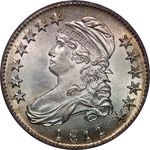
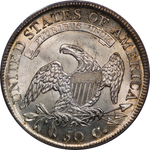
|
| 18 | 1812 | O.104 | R.1 | PCGS MS 61 | Luster rolls beneath original, antique grey toning. The surfaces are immaculate. The reverse is choice UNC. Dark areas on Liberty’s cheek and lower neck account for the conservative grade. From the Davignon Collection, acquired privately in March 2014. Est. $2,500 to $3,000 | 1 | $2,400 | $2,777 | $2,640 |
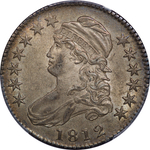
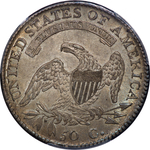
|
| 19 | 1813 | O.108 | R.3 | PCGS AU 55 CAC | Natural grey toning shimmers with iridescent gold highlights. This one has the look of a coin that was wrapped in tissue paper or, perhaps, stored in an envelope for a few decades ala Eric Newman’s coins. The coin is probably better than “55.” Commercial grading, however, is influenced by strike. This die pair is known for soft impressions. Still, a very pretty coin -- and an 1813 to boot! Est. $ 1,150 to $1,500. | 9 | $1,781 | $1,783 | $1,959 |
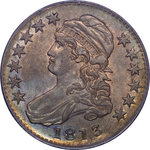
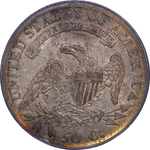
|
| 20 | 1814/3 | O.101a | R.2 | PCGS AU 58 | Lightly toned with full, flashy luster. The surfaces display the usual assortment of die breaks and clash marks but show virtually no signs of contact with other coins. The `14 over `13 is a bust half with character. It reminds us how precious working dies were in the early Mint. Unused dies were polished, punched and put to service in later years. Worn and damaged dies were used until they fell apart. This Red Book variety is plentiful in low and mid-grade. Choice AU examples are another matter. Est. $3,800 to $4,500. | 2 | $3,001 | $3,001 | Not Sold |
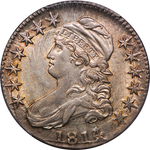
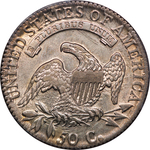
|
| 21 | 1814 Single Leaf | O.105a | R.4 | PCGS XF 45 | The `14 Single Leaf is a noted rarity in grades above VF. The soft impression is mandatory. This example enjoys pale gold iridescence around the stars, flanking centers that exhibit a light grey patina. Luster flickers around the devices. The Frederick and Newman coins were also graded XF 45. They brought $1,064 and $1,880, respectively. Est. $1,000 to $1,500. | 7 | $1,855 | $1,875 | $2,041 |
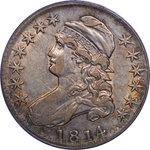
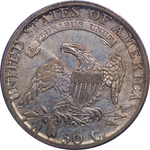
|
| 22 | 1814 | O.106 | R.5 | PCGS VF 25 CAC | The smooth surfaces are a delight. This die pair is the stopper in a set of 1814’s, yet it has a way of flying under the radar at auction. Check your AMBPR. Problem-free examples, of course, do not go unnoticed. Here is an example. A sweet VF R.5 is just what the doctor ordered for most die variety collectors. Est. $500 to $900 | 7 | $1,255 | $1,255 | $1,380 |
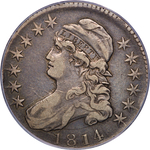
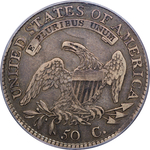
|
| 23 | 1817/3 | O.101a | R.2 | PCGS AU 55 CAC | Ex Don Frederick, last offered during the 2016 ANA Convention, MB 43, lot 27, where it brought $5,170. The winning bidder recently captured an UNC 1817/3 and graciously consigned this glorious piece to the current sale. Here is the description from MB 43: From the Don Frederick Collection, noted on the PCGS label. Frederick had several examples of this overdate. This was his favorite, holding forth as his set-piece. Scandalous original toning features electric shades of turquoise, blue, gold, copper and antique grey. This is “wow” coin for eye appeal. The undisturbed surfaces are essentially without flaws. It took $3,737 to bring it home in April 2010. (Heritage Central States sale, lot 2974.) It will cost more today – and be well worth it! Est. $4,500 to $5,500. |
8 | $4,851 | $5,011 | $5,336 |
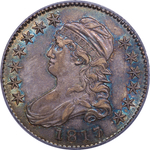
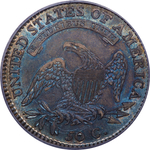
|
| 24 | 1817 | O.104a | R.6 | PCGS VG 8 | This coin may bring more bids than any other in the sale. The `17-104 is among the most sought after die pairs in the capped bust series. Oddly, the sparse population is “top heavy:” There are more examples in XF or better than in lower grades. I need but one hand to count the number of modest grade pieces that have come to market over the past 25 years. If you are not familiar with striking characteristics of the `17-104 do not be alarmed by the photo. Most examples are “rockers.” They appear bent when laid heads down. The wear pattern is just what we expect. The anomaly results from a massive fracture in the obverse die. John Cobb located the first known example in the mid-1960’s, calling it his “greatest find” and christening it The Moonbreak 1817. The Cobb coin found its way to the Overton Collection via Steve Markoff circa 1967 and remains there to this day. In 1993 NGC conferred a grade of AU 58. The 2nd and 3rd examples of the die pair were located by Sam Nolt and Don Gunnet, BHNC members Nos. 4 and 13. The Nolt and Gunnet coins were also AU. Gunnet sold his example to Charlton Meyer in 1977. Nolt passed his to Dr. Gerald Schertz in 1984. The current offering came to the consignor by private treaty from BHNC member Don See. Dark grey fields and light grey devices are typical of well circulated coins. This is a wholly honest coin, free of defects, awaiting a meeting with its new owner. Est. $4,000 and up – perhaps way up | 3 | $5,450 | $5,450 | $5,995 |
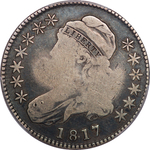
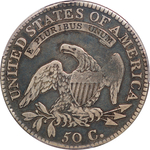
|
| 25 | 1817 | O.108 Prime | R.7? | PCGS AU 50 | Gold toning throughout, somewhat uneven. The surfaces show a few signs of handling, consistent with the AU 50 designation. As a die marriage, the O.108-108a is a scarce R.4. Virtually all are O.108a, featuring three obverse die breaks: 1. through stars 3-7 to cap; 2. through lower tips of star 8 to bust; and 3. from rim between stars 10-11 to bust. Until this piece appeared I thought the first die break was #3 in the foregoing list. This high-grade coin, however, has no sign of a die break at stars 10-11. There is the faintest imaginable break joining the lower tips of star 8. I’ve offered but two prime O.108’s in past sales, both XF 40: MB 28, lot 132, June 2003 @ $2,957; and MB 33, lot 201 Aug. 2007 @ $1,949. Est. $650 to $1,250. | 9 | $2,801 | $5,000 | $3,081 |
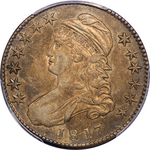
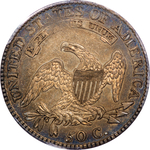
|
| 26 | 1817 | O.113a | R.4 | PCGS MS 62 OGH | An intensely lustrous example with a ring of pastel rose and copper toning that floats through the stars and legend. Die breaks pass through and over the date. The surfaces are free of blemishes save for a short hairline at the tip of star 4. This is an eye-catching coin! From the Davignon Collection, acquired at Stack’s-Bowers’ Nov. 2012 Baltimore sale, lot 1676. Est. $3,200 to $4,000. | 3 | $3,650 | $5,111 | $4,015 |
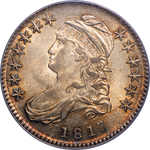
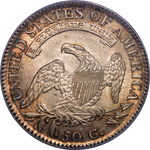
|
| 27 | 1818 | O.105 | R.3 | PCGS AU 53 CAC | Classic “grey dirt.” Full luster (on a 53!) is muted only by the original grey patina. Do not be deceived. This is a very high grade coin. The few traces of friction are confined to high points of the coin. The surfaces are nearly perfect. From the collection of Dick Graham, long known for his discerning eye. Est. $700 to $1,000. | 4 | $1,000 | $1,536 | $1,100 |
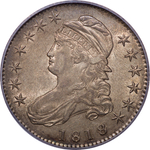
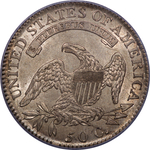
|
| 28 | 1818 Disc. Coin | O.110 | R.4 | PCGS AU Details | From the Dr. Charles Link collection; earlier in the Charlton Meyer collection. The PCGS label notes the “Meyer-Link” provenance. Link acquired the piece in Aug. 2009 when offered as lot 16 in MB 34 (selections from the Meyer collection). The coin has AU details. A net grade would be XF 45 because of hairlined surfaces. The coin is untoned with a few signs of circulation, nothing worth mention. Floyd Farley identified and described this scarce die pair after it appeared in a Feb. 1968 RARCOA sale. His BHNC clubmates dutifully labeled the variety 1818 FF.1 – appending Farley’s initials to honor his discovery. The variety became O.110 when Al Overton issued his 2nd edition in 1970, rating it R.6. This is the third appearance of the coin in my auctions. Meyer acquired it 1997 from MB 19 where it appeared as lot 9. Est. $700 to $1,000. | 2 | $650 | $650 | $715 |
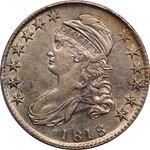
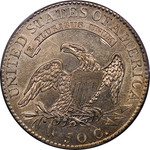
|
| 29 | 1819/8 Lg.9 | O.104 | R.1 | PCGS AU 58 CAC | A flashy, lightly toned example of the overdate. The surfaces are exceptionally smooth, a feature that helped earn CAC’s seal of approval. From the Davignon Collection; earlier in the collections of Michael Summers and David Kahn. Acquired by private treaty, Nov. 2008. Est. $2,500 to $3,250. | 2 | $2,700 | $2,700 | $2,970 |
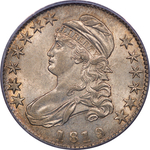
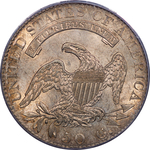
|
| 30 | 1819 | O.113 | R.1 | PCGS AU 55 CAC | Rich peripheral toning frames the fully lustrous fields and devices. Friction is confined to the highest points. This date is a stepchild to the 1820’s and nearly as tough to find in choice AU. Here is a lovely example, well deserving of CAC’s seal of approval. Est. $1,000 to $1,500. | 14 | $2,312 | $3,100 | $2,543 |
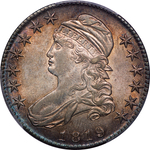
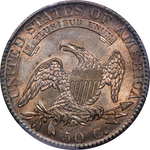
|
| 31 | 1820/19 Curl 2 | O.102 | R.1 | PCGS AU 58 CAC | A gorgeous coin, plucked from a Dansco album at the Nov. 2009 Baltimore show where Keith Davignon was the first to pounce on it. The strike is better than most from this pair of dies, though not without a hint of weakness in the curls over Liberty’s brow. Full luster radiates beneath iridescent pale copper album toning. This is a virtual twin to the PCGS AU 58 CAC example offered in Mail Bid 43 this past August. (Lot 31 @ $5,720.) Est. $4,500 to $5,500. | 3 | $4,000 | $4,400 | $4,400 |
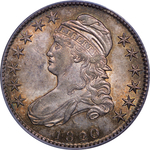
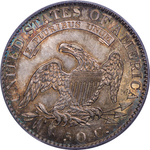
|
| 32 | 1820/19 Curl 2 | O.102 | R.1 | PCGS AU 55 CAC | Another example of the curl 2 overdate -- this with a bit more friction on the high points. The toning is amazing! Iridescent shades of rose and copper highlight the peripheries. The obverse fields are alive with electric blue and turquoise. Luster meets our expectations for the assigned grade. Preview is a must if you are to compete for this one. This date has a way of topping our estimates. Do not be shy when bidding on any 1820! Est. $3,000 to $3,500. | 7 | $3,400 | $3,400 | $3,740 |

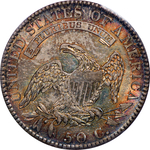
|
| 33 | 1820 Lg. Dt., Knob 2 | O.105 | R.1 | PCGS MS 61 CAC | From the Dr. Charles Link collection, noted on the PCGS label. This is another beautiful 1820. The glow of a fading tropical sun surrounds the portrait, imparted, one supposes, by album storage. The central designs from this era (1819-1822) are the most intricate and appealing of the entire capped bust series. With its low mintage, behind only 1815 and 1807, it is no wonder that all 1820’s are coveted in high grade. You won’t go wrong stretching for this one! Est. $3,000 to $4,000. | 5 | $3,900 | $3,900 | $4,290 |
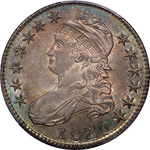
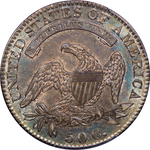
|
| 34 | 1821 | O.101a | R.1 | PCGS XF 45 CAC | Antique grey toning with soft luster throughout, hallmarks of an original coin. The obverse strike is a tad blunt. If your set does not require AU’s or UNC’s, this is your coin. Est. $325 to $450. | 4 | $300 | $543 | $330 |
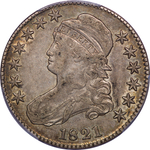
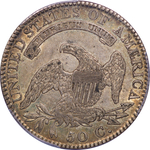
|
| 35 | 1821 | O.105a | R.1 | PCGS AU 58 CAC | Bold, unbroken luster confirms the grade. Subtle turquoise iridescence is a nice bonus. There is a trace of friction on the cheek. The reverse appears UNC. Here is a dandy coin for a date or type collector. From the Davignon collection, acquired privately from your cataloguer in June 2015. Est. $2.300 to $3,000. | 0 | $0 | $0 | Not Sold |
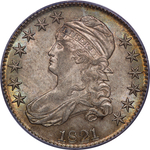

|
| 36 | 1821 | O.106 | R.1 | PCGS AU 55 CAC | The electric blue peripheral toning and pale rose centers yield a spectacular 1821. Minor luster breaks in the fields prevent a “58” designation, but the eye-appeal is off the charts for a “55.” Est. $1,300 to $1,700. | 2 | $1,500 | $1,955 | $1,650 |
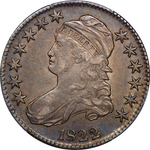
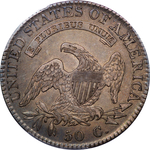
|
| 37 | 1822 | O.105 | R.3 | PCGS AU 58 | Untoned with full, flashy luster. You’ll love the detail in Liberty’s curls! High rims, crisp dentils and 13 stars with center-points suggest an early die state. Ex Donald Frederick, purchased by Dr. Charles Link at Heritage’s April 2010 sale: lot 3022 @ $1,725. The PCGS label mentions the Frederick-Link provenance. Est. $1,300 to $1,800. | 3 | $1,400 | $1,500 | $1,540 |
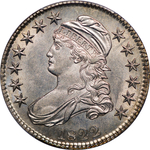
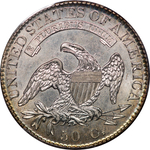
|
| 38 | 1822 | O.106 | R.3 | PCGS VF 35 CAC | Superb, original glossy-grey toning. The surfaces are exceptionally smooth. Simply put, perfect for the grade. Est. $200 to $300. | 4 | $220 | $244 | $242 |


|
| 39 | 1822 | O.108a | R.3 | PCGS AU 58 | An enthralling 1822! Semi-prooflike, especially on the reverse, and fully struck. A few streaks on the reverse are drift marks, common to the era, the result of imperfect refining techniques. It is a challenge to find even a hint of rub on this remarkable coin. I purchased the piece as agent for John Crowley at Superior’s sale of the Richard Pugh collection, June 1992 (lot 1153). Keith Davignon acquired it from the Crowley collection at the Aug. 2001 ANA Convention. Superior’s 1992 auction tag survives and accompanies the lot. Richard Pugh found this coin on the bourse floor of a 1987 Long Beach Show. Richard was a knowledgeable, enthusiastic student of bust half-dollars. His cherry-picks were legendary and included 3(!) 1827 O.137’s along with one of 2 known 1805 O.114’s. He was the primary consultant to Don Parsley in the preparation of the long awaited 1990 revision [3rd ed.] of Overton’s standard reference. He succumbed to brain cancer in early 1992. He was only 45. Est. $1,800 to $2,500. | 5 | $2,201 | $2,201 | $2,421 |
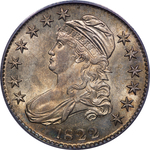
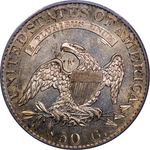
|
| 40 | 1822 | O.113 | R.3 | PCGS MS 63 | From the Davignon collection, found on the bourse floor during the 2003 ANA Convention. A blast of vibrant luster greets the eye. Frosty, untoned centers are framed with halos of russet toning. There is not a hint of friction on the devices; contact marks are virtually non-existent. The strike is first rate. In short, an ideal coin for an ambitious type or date collector. This was the last coin consigned to the sale. Keith uncovered and purchased an ethereal `22-113 at the recent Baltimore show. He explained, “[It] did indeed turn out to be a [George] Plimpton [family] Hoard coin. It was lot 700 in the 1981 NASCA sale of the Providence Collection, one of the 3 confirmed Plimpton Hoard auctions. I was able to identify it with 100% certainty from position of minor toning spots in the catalog photos.” Keith’s sleuthing and good fortune shook loose the coin offered here. Est. $3,250 to $4,250 | 3 | $3,500 | $4,511 | $3,850 |
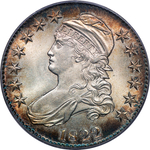
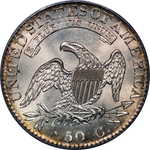
|
| 41 | 1822 | O.114 | R.3 | PCGS AU 58 CAC | The crust of antique grey toning is enriched by arcs of gold and copper toning through the stars and legend. If you like “original” busties, this one is for you. Est. $1,400 to $1,700. | 7 | $2,200 | $2,200 | $2,420 |
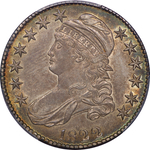
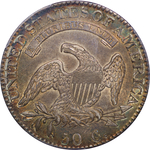
|
| 42 | 1823 | O.109 | R.5+ | PCGS VF 30 | Medium grey fields, lighter on the devices. This is a wholesome, lightly circulated example, free of distractions. Now demoted to R.5+ status, I still think of this killer die pair as R.6. I’ve cherried exactly 1 example over the past 3 decades. This is a recent addition to the meager population. The consignor spotted it on eBay! Est. $2,300 to $3,000 | 1 | $2,300 | $2,500 | $2,530 |
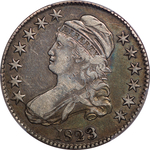
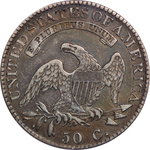
|
| 43 | 1823 | O.112 | R.1 | PCGS MS 63 | From the Dr. Charles Link collection, as noted on the PCGS label. Here is a sharply struck, prooflike specimen! Mint frost drips from the central devices, stark contrast to the mirror-like fields. The spaces between shield stripes are fully reflective. A few surface marks account for the “modest” grade. The bane of prooflike coins is a proclivity to preserve miniscule signs of handling or contact. Discard price guides when prooflike bust halves appear at auction. They are caviar to serious collectors. Est. $3,500 and up. | 4 | $3,500 | $3,800 | $3,850 |
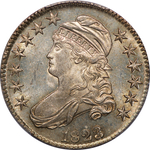
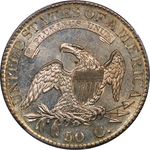
|
| 44 | 1824/1 | O.101 | R.2 | PCGS MS 64 | From the Dr. Charles Link collection, as noted on the PCGS label. An original coin with a multicolored patina and great depth of luster. The eye appeal is staggering. Aqua, gold, turquoise and rose are the dominant colors. Almost certainly kept for decades in a paper envelope. Truly, a coin for the connoisseur. Est. $7,500 to $8,500. | 1 | $7,000 | $7,000 | $7,700 |
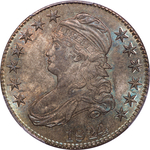
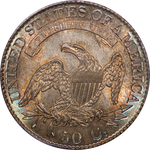
|
| 45 | 1824 | O.114 | R.5- | PCGS AU 53 CAC | A fabulous example of this noted rarity. (Al Overton considered it R.8.) The originality of the piece is unquestioned. The surfaces are clothed in a protective blanket of antique grey, darker in crevices that adjoin the devices. Richard Pugh taught me to expect mushy strikes on most die pairs rated R.5 or higher. The dies, after all, were often in short-lived marriages and at least one of them was usually nearing the end its working life. The `24-114 is an example. The obverse die saw long service on the O.113. Its marriage to a new partner was brief. High grade examples of the 114 are seriously rare. This example, from the Davignon collection, is among the top 6 or 7 known. It comes with a glorious pedigree. Keith acquired it in January 2012. Before then it served as a showcase coin in the collections of three noted collectors: Michael Summers, David Kahn and Brad Higgins. Est. $2,300 to $3,300. | 0 | $0 | $0 | Not Sold |
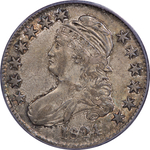
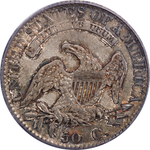
|
| 46 | 1824 | O.116 | R.3 | PCGS AU 58 CAC | Another reasonably common die pair in decidedly uncommon condition. This little beauty glows with original, iridescent toning, favoring the rustic colors of a fall afternoon in the Adirondacks. A couple of hairlines under the eagle’s beak are hardly worth mention. From the Davignon collection via Stack’s-Bowers’ March 2012 Baltimore sale, lot 3266. Est. $1,200 to $1,500. | 5 | $1,950 | $2,150 | $2,145 |
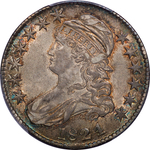
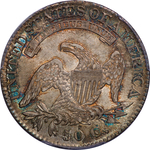
|
| 47 | 1825 | O.101 | R.1 | PCGS MS 63 | Scintillating luster will grab the inquiring eye from across a crowded room. A thin ring of gold encases the dentils. Beautifully impressed, save for hints of weakness at the drapery lines and the eagle’s left claws. The surfaces are immaculate. This offering has everything one expects of a choice uncirculated bust half. From the Davignon collection via eBay, March 2006. Yes, a knockout coin from eBay! Est. $2,750 to $3,250. | 0 | $0 | $0 | Not Sold |
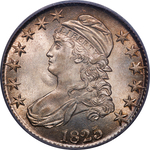
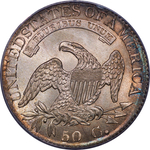
|
| 48 | 1825 | O.107 | R.2 | PCGS MS 61 CAC | Ex Don Frederick, noted on the PCGS label. This is a twin to the preceding 1825 O.101, with luster that is a touch less vibrant. There are minor signs of handling, nothing significant. An untoned coin with great “flash” for the modest grade. From the Davignon collection via Heritage’s April 2010 sale of the Frederick collection, lot 3091. Est. $1,500 to $2,000. | 0 | $0 | $0 | Not Sold |
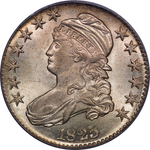
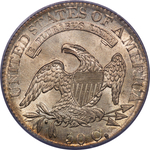
|
| 49 | 1825 | O.112 | R.3 | PCGS MS 61 OGH CAC | Another scrumptious coin with a distinguished provenance. Gehring Prouty acquired it from Henry Hilgard circa 1998. Dick Graham picked it up at the 2000 Philadelphia ANA sale of Prouty’s collection. In 2010 Graham sold it to the consignor, Keith Davignon. It would be difficult to string together a more knowledgeable group of collectors. Each chose well in adding this piece to his collection. The coin enjoys a protective silver-grey patina, nice surfaces and a healthy dose of vibrant luster. Est. $1,700 to $2,200. | 1 | $1,700 | $1,742 | $1,870 |
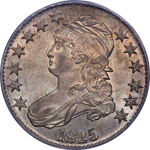
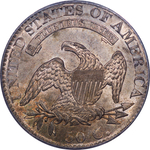
|
| 50 | 1825 | O.116 | R.3 | PCGS MS 63 CAC | Silver-grey with a veil of gold at the peripheries. Booming luster blankets the smooth surfaces. Striking weakness is confined to the left-hand stars and the lowest drapery lines. A first-rate MS 63! From the Davignon collection, found on the bourse floor during the 1999 ANA Convention. Est. $2,400 to $3,000. | 2 | $2,500 | $2,800 | $2,750 |
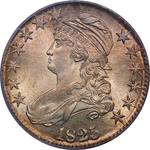
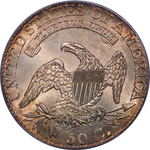
|
| 51 | 1826 | O.103 | R.5- | PCGS AU 58 CAC | With but 2 or 3 uncirculated examples known, this piece is a mid-level entrant to the Condition Census. The coin is untoned, with full cartwheel luster. The strike is far superior to most seen from this rare die pairing. Stray hairlines are noted under magnification. PCGS and CAC found them of no consequence. I agree. Don Frederick uncovered the coin more than 40 years ago. It was then the finest known. He sold it to Russ Logan in December 1976. It appeared as lot 2471 in B&M’s Nov. 2002 sale of the Logan collection. Logan detested slabs. He kept his coins “raw,” storing them in paper envelopes. Logan recognized only two AU grades: 50 and 55. He called this one “55.” Keith Davignon attended the Logan sale. He pounced when lot 2471 crossed the block, knowing it was an important opportunity. High grade R.5’s, it will be remembered, are caviar to advanced collectors. The Logan auction tag as well as his personalized insert accompany this lot. Est. $3,500 to $4,500. | 2 | $5,025 | $6,525 | $5,528 |
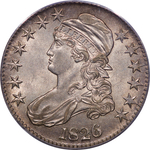
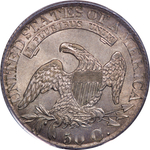
|
| 52 | 1826 | O.106a | R.3 | PCGS AU 58 OGH CAC | Draped in pastel gold toning, this eye-catching coin sparkles with luster. The surfaces are virtually free of contact marks. As expected of a “58,” only traces of friction appear on Liberty’s cheek and tops of the eagle’s wings. Another winning coin! Est. $950 to $1,300 | 3 | $1,000 | $1,100 | $1,100 |
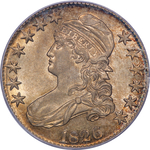
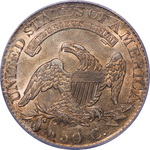
|
| 53 | 1826 | O.107 | R.3 | PCGS AU 58 CAC | An unassuming coin, essentially without flaws. I’ve adopted Floyd Farley’s use of the term “grey dirt” to describe the few, fortunate bust halves that lay undisturbed long enough to acquire a protective grey patina. Here is an example. Luster is deep and unbroken. The only hint of friction is at the tip of Liberty’s cap. This is the scarce “prime” die state. Overton describes 3 reverse die breaks. This example has none. All in all, a connoisseur’s coin. From the collection of Dick Graham. Est. $1000 to $1,500. | 6 | $950 | $950 | $1,045 |
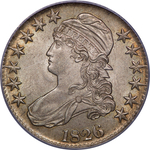
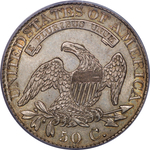
|
| 54 | 1826 | O.115 | R.5- | Raw AU | Yet another fancy R.5. From the Davignon collection, ex Mike Summers and David Kahn (in 2008). This is a VERY high grade example, near Condition Census. It apparently failed in its one visit to PCGS. The surfaces are free of marks or obvious hairlines. For a coin that is a smidgen short of UNC the cartwheel luster is subdued. Not absent, but not imposing. I’ll guess that PCGS was concerned about the impaired luster or, perhaps, the slightly uneven toning. The strike is from an early state of the dies. Note the high obverse rims, sharp dentils and well detailed curls. Keith settled on an AU 53 grade. Most would suggest a notch or two higher. Est. $700 to $1,200. | 8 | $1,200 | $1,200 | $1,320 |
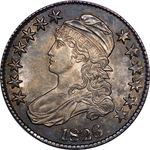
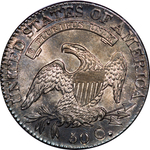
|
| 55 | 1826 | O.118a | R.1 | PCGS MS 62 | Natural auburn-grey toning with unbroken creamy luster. Well struck centers. Drawn stars confirm a later die state. One contact mark on the horizontal shield stripes may have kept this original coin from a choice designation. From the Davignon collection via Heritage’s Jan. 2011 sale of Troy Nelson’s coins (The Allgood Collection). Heritage inexplicably discarded Troy’s notes on provenance. Est. $1,500 to $2,000. | 1 | $1,500 | $1,912 | $1,650 |
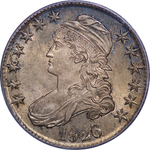
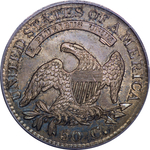
|
| 56 | 1827 | O.105 | R.3 | PCGS MS 61 | Largely untoned with exceptionally bold, undisturbed luster for this modest grade. The strike is a marvel! Check the detail in Liberty’s curls and the eagle’s claws. From the Davignon collection. Acquired privately from your cataloguer in Aug. 2001, then in an NGC MS 62 holder. Est. $1,400 to $1,800. | 2 | $1,300 | $1,300 | $1,430 |
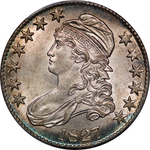
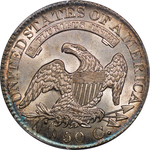
|
| 57 | 1827 Sq. Base 2 | O.113 | R.4- | PCGS AU 58 CAC | An uncirculated coin with a trace of cabinet friction on the cheek. Lightly toned with intense luster and a superior strike. The provenance of the coin bespeaks its eye appeal. From the Davignon collection, earlier in the collections of Robinson S. Brown, Jr. (via Heritage’s 1994 ANA Auction, lot 5360), Gehring Prouty and Charles De Olden. Removed from an NGC MS 61 holder after its appearance in MB 32, June 2006, lot 80 – the De Olden Collection Sale. The 1994 Heritage auction tag accompanies. Est. $1,300 to $1,800. | 2 | $1,275 | $1,275 | $1,402 |
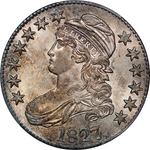
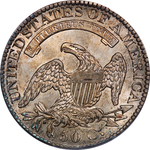
|
| 58 | 1827 Sq. Base 2 | O.122 | R.5 | PCGS AU 58 CAC | From the Dr. Charles Link collection, earlier in the Frederick collection, as noted on the PCGS label. Here is one of the 2 or 3 most important coins in the sale. Frederick’s 2x2 envelope accompanies. He wrote (in July 1980), “Easily the finest known of this very rare variety. Beautifully toned and choicely preserved, AU/AU+.” One uncirculated example has since surfaced, the De Olden PCGS MS 64, offered in MB 32, June 2006, lot 83, @$9,533. The Frederick/Link coin stays at #2 in the Condition Census, tied with the Meyer coin, also graded PCGS AU 58 (sold privately in July 2008 for $5,800). The toning on the current example is otherworldly! Preview is necessary. Any description will fall short, but must allude to the rose colored centers, surrounded by electric shades of turquoise and blue. Contact marks are absent. Cartwheel luster is undiminished in the fields. There is but a trace of friction on Liberty’s cheek. Enough said. Early congratulations to the winner! Est. $6,000 and up. | 6 | $6,258 | $8,111 | $6,884 |
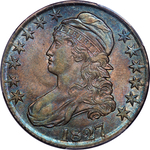
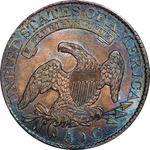
|
| 59 | 1827 Sq. Base 2 | O.127 | R.5 | PCGS AU 53 | From the collection of Dr. Charles Link, noted on the PCGS label. Soft luster throughout; light to medium grey toning with some hints of golden iridescence around the stars and legend. The strike is superior to most. In the 1990’s a spate of low to mid-grade 127’s brought the rarity down from Overton’s 2nd edition rating of R.7 to its current R.5. High grade examples, however, remain elusive. Witness Stew Witham’s PCGS AU 55 at $8,050 in Aug. 2010 (Heritage ANA sale, lot 4901), the Dosier-Prouty AU 55 @ $5,250 in Aug. 2000 and lot 54 of the recent MB 43, a PCGS AU 55 @ $4,291. The current offering lies just outside the Condition Census but rests comfortably within a register of the top 10 examples. Est. $3,000 to $4,000. | 1 | $3,750 | $5,375 | $4,125 |
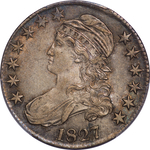
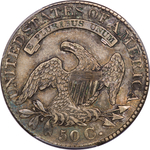
|
| 60 | 1827 Sq. Base 2 | O.129 | R.4- | PCGS MS 61 OGH CAC | An old friend. I purchased this coin for a Pennsylvania collector at B&M’s Nov. 1991 Frontenac Sale. Lot 3144 brought $1,017. It was in the same PCGS holder as today. The Frontenac Sale was notable for at least two reasons. First, along with a raft of nice coins, the sale included a small consignment from James Brilliant; the rest of his amazing collection appeared in B&M’s Jan. 1992 FUN show sale. Second, a wet-behind-the-ears collector, Keith Davignon, sat in the audience, watching – and learning. He wondered who the two fellows in the front row were that bought so many coins: yours truly (representing a dozen absent bidders) and Gehring Prouty. This coin found its way back to my inventory in September 2002. Keith, having missed it in 1991, did not repeat his mistake. The coin is clearly nicer than “MS 61.” The centers are sharply struck, the luster bold and the surfaces next to perfect. Est. $1,500 to $2,500. | 5 | $2,335 | $3,111 | $2,568 |
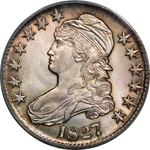
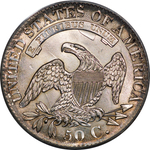
|
| 61 | 1827 Sq. Base 2 | O.131 | R.2 | PCGS AU 58 CAC | Silver and pale gold toning, the reverse with iridescent toning through the legend. Unbroken luster through the fields, expected of a “58.” Decent strike. May be an early die state – I see heavy vertical die lines under the left wing that are unmentioned in Overton. Perhaps they were polished off early in the life of this common die pairing. From the Davignon collection; acquired privately in Feb. 2002. Est. $1,100 to $1,400 | 10 | $1,563 | $1,891 | $1,719 |
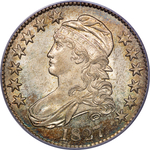
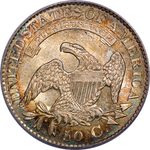
|
| 62 | 1827 Sq. Base 2 | O.138 | R.4 | PCGS AU 58 CAC | Bold, satiny luster is infused with gorgeous highlights of iridescent gold, aqua and pale rose. The surfaces are immaculate. Here is a scarce die pair that earns an “A” for eye appeal. It will take a stretch bid to capture this beauty. Est. $2,000 to $3,000. | 9 | $3,950 | $4,550 | $4,345 |
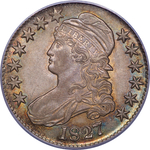
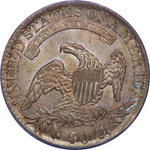
|
| 63 | 1827 Sq. Base 2 | O.142 | R.3 | PCGS MS 62 CAC | A wonderfully original coin. Unbroken cartwheel luster rolls beneath a blanket of golden toning. The lovely surfaces will please the most discerning collector. Acquired from your cataloguer in April 2012, earlier in the collection of Dr. Charles Link. Est. $1,750 to $2,250. | 3 | $1,800 | $2,825 | $1,980 |
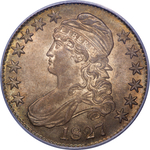
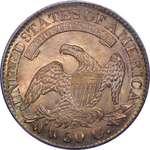
|
| 64 | 1828 Curl 2, No Knob | O.101 | R.1 | PCGS AU 58 CAC | Iridescent rings of album toning run through the stars and legend. I fail to see either friction or luster breaks on this well struck beauty. No marks deserve mention. A few wispy hairlines may account for the conservative grade. This is a great coin for the Red Book collector. From the Davignon collection via your cataloguer in Dec. 1997 as “UNC.” Keith graded it AU 62. Est. $1,300 to $1,700. | 6 | $2,550 | $2,600 | $2,805 |
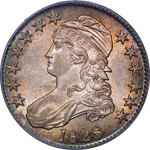
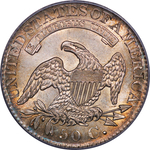
|
| 65 | 1828 | O.105 | R.5 | PCGS AU 58 CAC | A high R.5 in your cataloguer’s estimation. I know of a single uncirculated example, Stu Witham’s coin, graded PCGS MS 62. It brought $6,325 at Heritage’s 2010 ANA auction. This Condition Census piece turned up the following year and makes its first appearance at auction. The strike is exceptional for the issue. The satiny surfaces are bathed in even, auburn toning. No marks deserve mention. A toning spot in the field, between the eagle’s neck and top left wing, will serve as a marker for future generations. Three or four choice AU’s are known. I doubt that the total population exceeds 45 coins. If you have chased scarce and rare die marriages for any time at all you know the significance of this opportunity. Acquired privately from David Kahn. The consignor’s insert details the acquisition. Est. $4,000 to $5,000. | 1 | $3,500 | $3,500 | $3,850 |
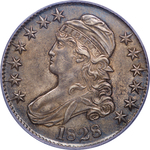
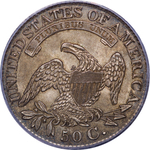
|
| 66 | 1828 | O.105 | R.5 | PCGS AU 55 CAC | Imagine the shock when a 2nd AU specimen came in, part of a separate consignment! I sent both coins off to CAC. Each received green-bean approval. Silver-grey toning softens but does not conceal nearly full luster. The strike is typical for a `28-105, falling a notch short of the previous offering. The surfaces display minimal signs of contact. Here is a near Condition Census piece that may require you to bone up on the One-Lot-Only option available in my auctions. Another private treaty acquisition from my long-time friend David Kahn. Est. $3,000 to $3,750. | 0 | $0 | $0 | Not Sold |
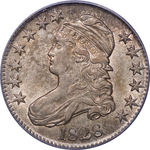
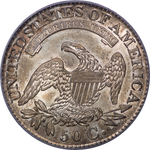
|
| 67 | 1828 Curl 2 with Knob | O.107 | R.2 | PCGS MS 63 | From the collection of Dr. Charles Link, noted on the PCGS label. With a rarity rating of R.2 this Red Book staple (“curl 2 w/ knob”) is surprisingly – dare I say annoyingly – hard to find in high grade. Just 2 of 23 die pairs from 1828 feature a Curl & Knob 2. The other, O.106, carries a well-deserved R.4+ rarity rating. The Herrman and Rutherford auction price compilations chronicle five certified MS 63 O.107’s coming to auction over the past 4 years. (The Green-Newman coin appeared twice.) Prices ranged from $2,350 to $8,997 (MB 37, the Nomura coin). PCGS suggests a value of $5,500. Why such disparity? The quality of the coin matters. This one is nice! The strike is first rate; the luster deep and undisturbed; the eye appeal meets expectations for a choice uncirculated bust half. The lightly toned surfaces have a few ticks from contact with other coins, nothing of concern. Don your bidding boots! Est. $4,000 to $5,000. | 0 | $0 | $0 | Not Sold |
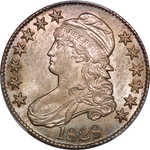
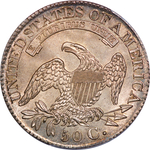
|
| 68 | 1828 Sm.8, Lg. Lets | O.115 | R.2 | PCGS MS 64 | From the Davignon collection. Last appearing in MB 36, my 2012 ANA Sale. Lot 51 brought $3,532 and was described as follows. The epitome of ‘grey dirt’ and 100% original. The stewards of this coin for the past 184 years deserve a bow. Aside from the protective grey patina it remains as struck. Cakey, undisturbed luster rolls beneath the toning. There are virtually no handling marks. The strike is first rate. Here is a coin without faults, looking forward to continued repose in an advanced collection. I repeat – original! Est. $3,200 to $4,000. | 0 | $0 | $0 | Not Sold |
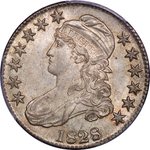
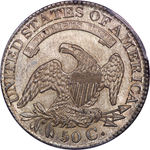
|
| 69 | 1828 Sm.8, Lg. Lets | O.116 | R.2 | PCGS MS 62 CAC | Oh, my goodness! Perhaps the prettiest coin in the sale. The smooth fields and devices are coated with entrancing shades of rose and turquoise. And check out the detail in Liberty’s curls – including those over and behind the ear. Die lines, left of the date, confirm an early die state. A tick on the chin appears to be of Mint origin, a minute depression in the planchet. This is a showcase coin with runaway potential. Est. $2,500 and up. | 5 | $4,000 | $4,250 | $4,400 |
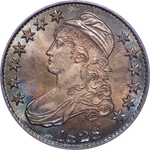
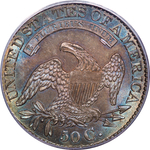
|
| 70 | 1828 Sm.8, Lg. Lets | O.117 | R.1 | PCGS AU 58 | From the Davignon collection, formerly in the Link collection, noted on the PGCS label. An intensely lustrous coin with hints of prooflike surfaces inside the stars. Halos of colorful toning circle the stars and legend. Well struck, especially the eagle’s claws and feathers. Another pretty AU 58! Est. $1,200 to $1,500. | 3 | $900 | $1,100 | $990 |
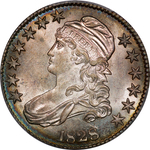
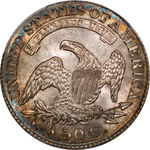
|
| 71 | 1828 Sm.8, Sm. Lets | O.119 | R.3 | PCGS AU 55 CAC | An original “grey dirt” coin, with a blush of pastel gold toning. As with the earlier 1828 O.107, this variety – the Small Letters Reverse – is under intense pressure from Red Book and Registry Set collectors. Do not be misled by the R.3 rarity rating: only one die pair of the year uses the small letter punch. The last CAC approved AU 55 brought nearly $2,000 (lot 4978, Heritage 2015 ANA Sale). PCGS now suggests a value of $1,850. This eye-appealing example is essentially without faults. From the Davignon collection. Purchased from your cataloguer in Nov. 2009. Keith writes, “… gorgeous original coin, perfect for grade.” Est. $1,600 to $2,500. | 7 | $3,350 | $3,500 | $3,685 |
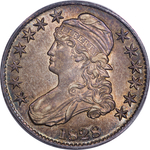
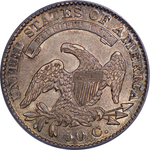
|
| 72 | 1828 Sm.8, Lg. Lets | O.122 | R.3 | PCGS MS 60 | A VERY old friend. I sold this coin to Richard Pugh back in 1986. Richard submitted it to a newly formed grading service – PCGS. It was returned in a first-generation holder, graded MS 60. At the May-June 1992 Superior Galleries’ Jack Adams Sale (including the Pugh collection) I bought the coin for the account of John Crowley. Keith Davignon picked it off at the 2001 ANA Convention where I offered coins from the Crowley collection. Keith had the coin reholdered sometime thereafter. (First generation PCGS holders are called “rattlers” for a reason.) I enjoyed Keith’s candid remarks, scribbled on his consignment sheet: We only wish that all of our MS 60’s looked like this! The coin is sharply struck, though a later die state, displaying crumbling at the rim between stars 5 and 6 and a feathery die break from star 2 to the bust. Unbroken luster, obverse and reverse. The obverse fields are slightly busy; the reverse is immaculate, supporting a choice to select uncirculated designation. Est. $1,300 to $1,700. | 1 | $1,300 | $1,612 | $1,430 |
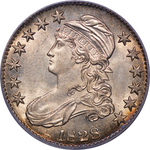
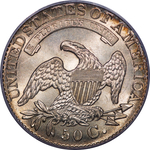
|
| 73 | 1828 Sm.8, Lg. Lets | O.123 Prime | R.7 | ANACS EF Details | An offering that will entice advanced collectors and students of the series. Light to medium grey toning, with hints of luster; no marks of consequence. The “flat” appearance results from an improper cleaning. (Is there any other kind?) The reverse die is free of damage, usually seen under the left wing. The obverse die is without the familiar rim break at stars 5-6. This early die state is exceedingly rare. Fewer than a dozen pieces are known. Strong prices are the norm for the few examples to appear at auction over the past 17 years. This coin confirms the existence of a remarriage between the obverse and reverse dies, a fact worth discussing. The earliest or perfect state of the obverse die shows no sign of a rim break between stars 5 and 6. (The case with this coin.) The die was first paired with a reverse die from the earlier struck 1828 O.113 and 114. The reverse die, though worn, was then free of the familiar “railroad tracks” below the left wing. (This coin provides the proof.) The obverse die, it appears, enjoyed little more than a honeymoon with its first partner. It was soon married to a new reverse die, that of the 1828 O.122. (See the preceding lot.) It was during this marriage that the rim break at stars 5-6 developed. After a respectably long second marriage (the O.122 is R.3) the obverse die returned (remarried) to its first partner. A few from this remarriage exhibit the obverse die break, but no damage (railroad tracks) on the reverse. Most, of course, show both a heavy die break on the obverse rim (heavier than on the O.122) and a damaged reverse die. Since the obverse die appears in its earliest and latest die states on the O.123 we know that the O.122 was struck after the earliest O.123’s and before the later O.123’s. Voila! A remarriage is confirmed. Est. $2,000 to $3,000. | 0 | $0 | $0 | Not Sold |
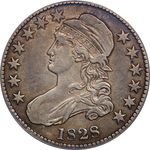
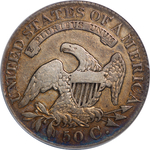
|
| 74 | 1829 | O.105a | R.1 | PCGS AU 58 CAC | From the Dr. Charles Link collection, noted on the PCGS label. The surfaces twinkle with golden highlights over light grey, moderately lustrous surfaces. High rims and full dentils are a bonus on this later die state. Est. $1,100 to $1,400. | 2 | $1,000 | $1,440 | $1,100 |
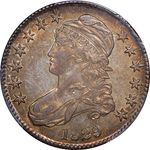
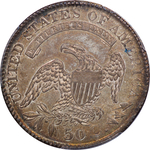
|
| 75 | 1829 | O.108a | R.3 | PCGS MS 62 CAC | Another beautiful coin from the Davignon collection. Earlier in the collections of Steven Nomura and Charles De Olden. Last appearing in MB No. 37, Aug. 2013 lot 54 @ $1,815, where concisely described: Silver-grey toning with russet highlights and bold luster compliment the unusually smooth surfaces. Superior eye appeal for the grade. From the Nomura Collection, acquired privately from your cataloguer in August 2006. Ex Charles De Olden Collection as ICG MS 64. Est. $1,500 to $2,000. | 0 | $0 | $0 | Not Sold |
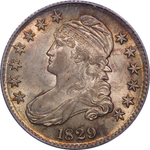
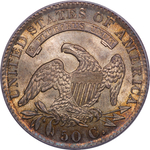
|
| 76 | 1830 Sm.0 | O.101 | R.1 | PCGS XF 45 CAC | Luster of a nice AU. PCGS was probably influenced by the weak rims and drawn stars, a product of the late die state. This is a sweet coin with original antique grey and pale gold toning. Acquired privately in Aug. 2014, earlier in the renowned collection of James Ross. Est. $300 to $350. | 0 | $0 | $0 | Not Sold |
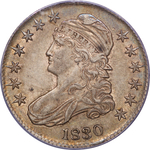
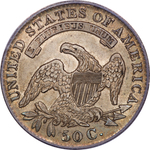
|
| 77 | 1830 Sm.0 | O.108 | R.3 | PCGS AU 58 CAC | Full cartwheel luster glistens beneath the pale gold patina. Nicely struck centers and a full motto will encourage the date or type collectors. A drift mark accounts for the shadow at the inner points of stars 1-3. Ex Dick Graham; acquired by the consignor at the Aug. 2014 ANA Convention. Est. $800 to $1,000. | 3 | $900 | $1,725 | $990 |
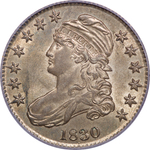
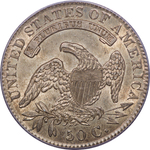
|
| 78 | 1830 Sm.0 | O.112 | R.4+ | PCGS AU 55 | From the Dr. Charles Link collection, noted on the PCGS label. Another piece for die variety collectors. The 1830 O.112 is a stepchild to the charismatic 1830 Large Letters O.114 R.5+. It emerged from the shadows when Heritage offered an NGC AU 58 specimen at its Feb. 2013 Long Beach Sale. It brought $2,115. I find no record of one graded PCGS AU 55 (or better) coming to auction over the past ten years! Steve Nomura’s NGC AU 55 brought $1,215 in 2013 (MB 37, lot 58). Dr. Link considers the piece offered here to be #3 in the Condition Census. Don Parsley, however, places 3 uncirculated examples in his CC, alongside 2 choice AU’s. The Link coin is charming. Flamboyant album toning frames the lustrous, lightly toned centers. The surfaces, though wiped, are virtually free of contact marks. An important coin for the specialist. Est. $1,200 to $2,000. | 1 | $1,250 | $1,350 | $1,375 |
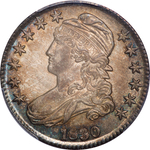
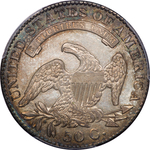
|
| 79 | 1830 Sm.0 | O.118 | R.3 | PCGS AU 58 | Intense, unbroken luster, surrounded by coveted “target toning,” lighter on the reverse. From the Davignon collection via my offering of John Tidwell’s remarkable assemblage (including an 1817/4) at the 2004 Pittsburgh ANA Convention, then in an NGC MS 61 capsule. Tidwell acquired the coin from your cataloguer in 1997. Est. $900 to $1,300. |
7 | $1,350 | $1,725 | $1,485 |
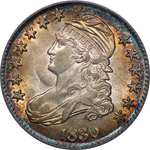
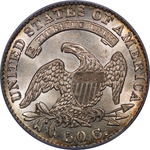
|
| 80 | 1831 | O.102 | R.1 | PCGS MS 62 | Satiny luster beneath delightful antique grey toning, a hallmark of originality. Very pleasing surfaces. From the Davignon collection. I chuckled at his consignment notes: Nice original coin with medium grey/blue toning; beautiful 58 with added benefit of being in a 62 holder. He acquired it from Dave Kahn at the 2015 spring Baltimore Show. Est. $1,100 to $1,500. | 1 | $1,050 | $1,725 | $1,155 |
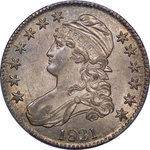
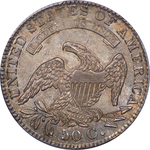
|
| 81 | 1831 | O.106 | R.3 | PCGS AU 58 CAC | Every bit as pretty as the photo suggests. Magnificent toning favors colors of a tropical sunset. Nice surfaces too. As I looked for hidden marks I found a familiar group of 3 dots on Liberty’s chest. They are the footprint of the mechanism used to eject freshly minted specie from the coining chamber. They are often seen on dates in the 1830’s. Est. $950 to $1,250. | 6 | $1,775 | $1,850 | $1,953 |
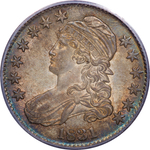
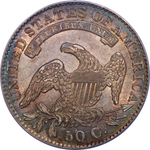
|
| 82 | 1831 | O.106 | R.3 | PCGS AU 53 CAC | Same date, same die pair as lot 81, but a little more wear from short term circulation. Soft cartwheel luster rolls under a blanket of pastel gold toning. Another coin with surfaces that are curiously – and happily – free of contact marks. Est. $425 to $575. | 0 | $0 | $0 | Not Sold |
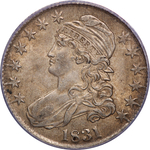
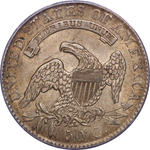
|
| 83 | 1832 Lg. Lets. Rev. | O.101 | R.2 | PCGS AU 55 CAC | Very early die state. The hallmark reverse die break is jagged and thin. Liberty’s cheek is fully rounded, her curls and drapery lines well defined. The surfaces are immaculate. Cartwheel luster falls just short of the radiance needed for an AU 58 designation. This is a “top shelf” coin from the collection of Dick Graham. Est. $500 to $800. | 4 | $500 | $501 | $550 |
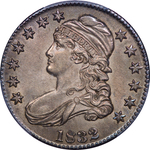
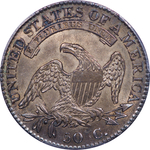
|
| 84 | 1832 | O.114 | R.4+ | PCGS MS 62 | A gorgeous example of this noted rarity. From the Davignon collection, acquired from Dr. Link during the 2010 ANA Convention in Boston. This is the 2nd or 3rd finest know of the variety. Lustrous surfaces are painted with colorful, iridescent shades of amber, russet and turquoise. The surfaces are excellent; I see only miniscule signs of contact. The obverse die, appearing first on the O.113, was nearing its end when married to a new reverse. Weak rims and drawn stars are mandatory. A quick key for cherry pickers is star 9. It is the only one with a point. The others are flat. Est. 3,000 to $4,000. | 0 | $0 | $0 | Not Sold |
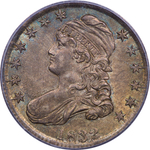
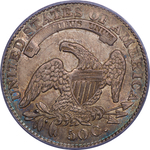
|
| 85 | 1832 | O.114 | R.4+ | PCGS AU 55 CAC | Unheard of! Two high grade 114’s in the same auction. (Have you checked star 9, to confirm the die pair?) The consignor found this one in Baltimore at the 2008 ANA Convention. Silver-grey toning, the reverse with some nice color. The coin saw little, if any, actual circulation. The surfaces are free of distractions. One-lot-only? Est. $1,400 to $1,800. | 1 | $1,350 | $3,100 | $1,485 |
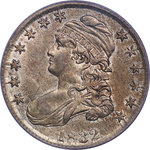
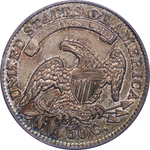
|
| 86 | 1832 | O.122 | R.1 | PCGS AU 58 | Blasting luster, the stars and right field are decorated with rainbows of album toning. Superb surfaces, nicely impressed central devices, and eye appeal par excellence. From the Davignon collection via your cataloguer’s June 2015 FPL. Est. 1,100 to $1,500. | 6 | $1,300 | $2,225 | $1,430 |
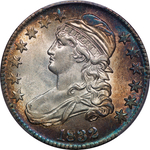
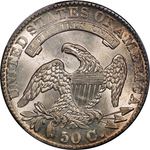
|
| 87 | 1833 | O.104 | R.1 | PCGS MS 64 | A common date and variety – in uncommon condition. Luster flows to wondrous depths under a blanket of original silver-grey toning. Not a hint of friction. The surfaces are immaculate save for a graze inside star 3. This is a marvelous coin for a type set. From the Davignon collection. Est. $3,000 to $3,500. | 0 | $0 | $0 | Not Sold |
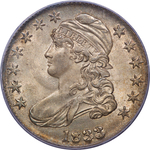
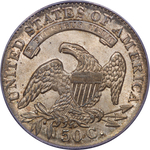
|
| 88 | 1833 | O.105 | R.2 | PCGS AU 55 CAC | Subtle iridescence augments splendid, original toning. The reverse offers beguiling splashes of color. Cakey luster, undiminished in the fields, begs for a higher grade. Est. $500 to $650. | 4 | $500 | $500 | $550 |
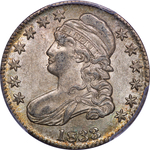
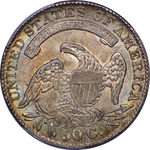
|
| 89 | 1833 | O.107 | R.3 | PCGS AU 58 CAC | Natural antique grey toning on the obverse; the reverse is outrageously toned in pastel colors of the rainbow. Nice! Est. $800 to $1,200. | 1 | $750 | $750 | $825 |
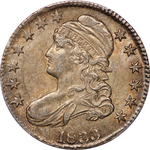
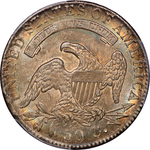
|
| 90 | 1833 | O.108 | R.1 | PCGS AU 58 CAC | From the Davignon collection; earlier in the Dr. Charles Link collection, noted on the PCGS label. Sharply struck! Natural antique grey centers, the stars and legend infused with iridescent aqua, gold and turquoise. Eye appeal! Acquired at the 2014 ANA Convention. Est. $800 to $1,200. | 4 | $1,700 | $1,750 | $1,870 |
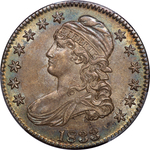
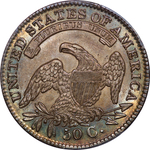
|
| 91 | 1834 Lg. Dt., Sm. Lets | O.105 | R.1 | PCGS MS 62 | Winsome grey patina with colorful iridescence through the stars, similar to the preceding 1833. A prototypical MS 62. From the Davignon collection via your cataloguer at the March 2010 Baltimore show. Est. $1,500 to $1,800. | 3 | $1,950 | $2,150 | $2,145 |
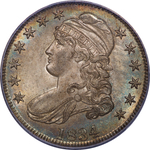
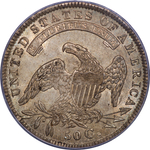
|
| 92 | 1834 Lg. Dt., Sm. Lets | O.108 | R.1 | PCGS AU 58 | Ancient pale bronze toning, a reward from lengthy storage in a paper envelope. The lighter reverse reveals the true depth of luster. Sharply struck central devices. The consignor purchased this coin from Dr. Link at the Aug. 2013 ANA Convention. Est. $750 to $1,000. | 0 | $0 | $0 | Not Sold |
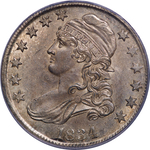
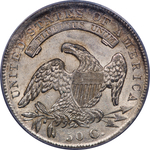
|
| 93 | 1834 Lg. Dt., Sm. Lets | O.108 | R.1 | PCGS AU 58 | Silver-grey toning, lighter on the reverse. Full cartwheel luster. Keith Davignon purchased the coin at Heritage’s Jan. 2006 sale of Jules Reiver’s bust halves (lot 23291), then graded NGC MS 61. Reiver’s white 2x2 envelope accompanies, noting his acquisition date, 6/6/86. Inside the envelope is a Heritage tag (from 1986) with the grade “AU 50/50.” Oh dear! Is this offering a low-end AU, a low-end UNC or something in between? Est. $700 to $900. | 0 | $0 | $0 | Not Sold |
.jpg)
.jpg )
|
| 94 | 1834 Sm. Dt.&Lets | O.116 | R.1 | PCGS MS 63 | Shimmering luster under a crust of amber toning. Immaculate surfaces save for the oft seen dots impressed by the ejection arm of the coining press, above and right of the date, cf. lot 80. From the Davignon collection via Heritage’s Platinum Night session, 2012 FUN Show, lot 3536. Est. $2,000 to $2,500. | 0 | $0 | $0 | Not Sold |
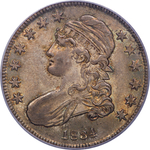
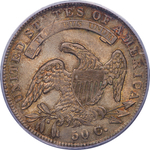
|
| 95 | 1834 Sm. Dt.&Lets | O.120 | R.4 | PCGS AU 58 CAC | Silver-grey toning with an especially “fresh” look to the surfaces. Thick, undisturbed luster. The barest trace of friction on the cheek. From the Davignon collection. An eBay find! One of the few scarce die pairs of 1834. Est. $1,000 to $1,350. | 4 | $1,315 | $2,622 | $1,447 |
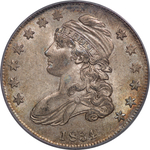
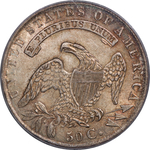
|
| 96 | 1834 Sm. Dt.&Lets | O.121 | R.3 | PCGS MS 62 | Vibrant luster befits this lightly toned survivor of the early Mint. The eagle’s claws are honed and lethal. From the Davignon collection, plucked from the bourse during the 2014 ANA Convention. Est. $1,400 to $1,750. | 0 | $0 | $0 | Not Sold |
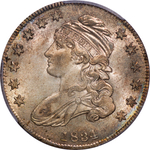
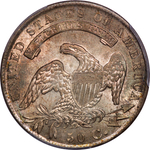
|
| 97 | 1835 | O.101 | R.1 | PCGS AU 58 CAC | Classic “grey dirt” from the Davignon collection. If you like `em original with cakey undisturbed luster here is your coin. Sharply struck! A quality coin for a quality collection. Est. $850 to $1,200. | 1 | $700 | $800 | $770 |
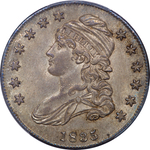
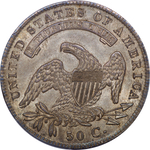
|
| 98 | 1835 | O.103 | R.2 | PCGS AU 53 CAC | From Dick Graham’s collection. Another original, battleship-grey coin; this one with hints of golden iridescence. A very high-end “53.” This date is tougher to find in high grade than others of the 1830’s. Est. $475 to $575. | 0 | $0 | $0 | Not Sold |
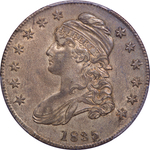
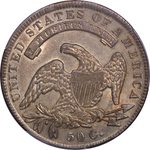
|
| 99 | 1835 | O.109 | R.2 | PCGS AU 58 CAC | Ex Frederick Collection, noted on the PCGS label. Silver-grey toning and, yes, it’s original. Luster glows from the depths of this nicely impressed 1835. Students of the series will tell you that the 1835 O.109 and 110 are the toughest die pairs of the year to find in choice AU. This and the preceding 2 lots would make wonderful additions to a first-class variety set of the year. From the Davignon collection, acquired privately during the 2015 Anaheim ANA Convention. Est. $900 to $1,250. | 2 | $925 | $1,015 | $1,018 |
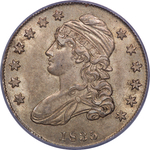
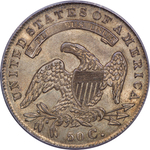
|
| 100 | 1836 Bar Dot | O.121 | R.5+ | PCGS VF 30 | On everyone’s short list of killer R.5’s. Medium grey fields, lighter devices. Luster hides in the star crevices. This moderately circulated piece should fit your budget. Consider pairing it with another rare variety in the sale, using the one-lot-only option. The consignor acquired this rarity from Dr. Glenn Peterson. Est. $1,500 to $2,250. | 7 | $2,000 | $2,000 | $2,200 |
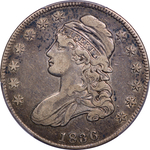
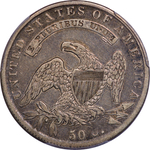
|
| 101 | 1837 RE | GR-1 | R.5 | PCGS AU 58 | A very scarce variety, esp. in high grade. The reverse die was first used on the rare 1836 reeded edge coins. This example, from Dick Graham’s remarkable collection, is a lustrous, untoned beauty. Est. $800 to $1,200. | 5 | $1,559 | $1,666 | $1,715 |
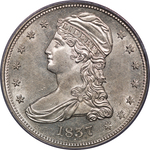
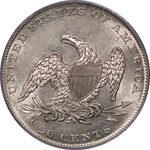
|
| 102 | 1838 RE | GR-4 | R.1 | PCGS MS 62 | Target toning, undoubtedly from storage in a cardboard coin-holder. An electric ring of iridescence sets off the lightly toned centers. Here is the eye appealing coin you wanted for your type or date set! Est. $1,750 to $2,500. | 3 | $1,750 | $2,050 | $1,925 |
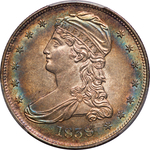
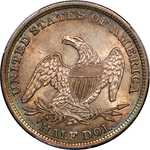
|
| 103 | 1839-O RE | GR-1 | R.1 | PCGS AU 58+ | A registry set collector’s dream. Pop 1! A blast of luster greets the eye when you examine this untoned, fully struck little princess. There is but a whisper of friction on Liberty’s cheek. The fields, with a few wispy hairlines, are utterly free of contact marks. We may be sure of two things: 1. the coin never saw circulation; and 2. there will be a battle-royal for custody of this final lot in the sale. Est. $10,000 and up. | 1 | $9,500 | $10,001 | $10,450 |
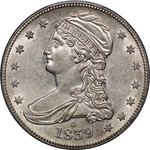
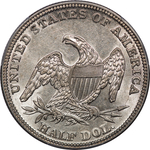
|
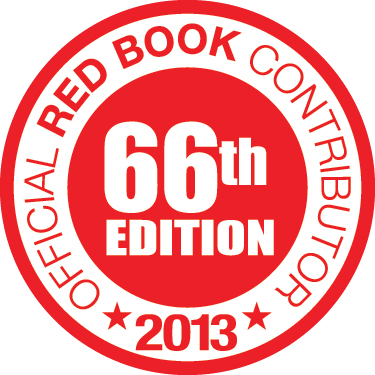

Sheridan Downey, Numismatist
4400 Keller Ave.,
Suite 140, PMB 398
Oakland, California 94605
sdowney3@aol.com
(510) 479-1585
©2024 Sheridan Downey